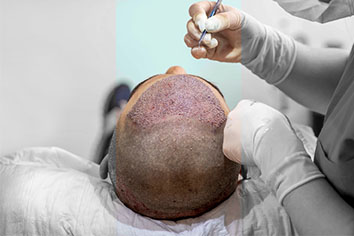Hair Transplantation

Hair Transplantation
Hair Transplantation is a proven way to restore hair thinning or bald areas of your scalp. The type of hair transplant surgery chosen depends on the pattern and extent of hair loss, lifestyle, desires, and situation of an individual. In Hair transplantation process, the healthy hair is taken from the donor area and transplanted into the recipient area(the area that needs hair).
After completing the after-care process, there is no need for additional care or maintenance costs. The new hair looks like the old one and can be washed and styled without any hassle. That’s why most people prefer hair transplantation over other medical procedures. Here is the Hairplantation process:
Harvesting From Donor Area
In the initial step of Hair Transplantation, hair follicles are trimmed from the donor area. After trimming, local anesthesia is given to the donor area. The tissue in the donor area contains bald resistant hair follicles that are removed surgically, and the donor area is sutured. The sutures in the donor area are hidden with the patient's hair. These sutures are removed after ten days after the hair transplantation surgery. Then, the donor tissue is trimmed into follicular unit grafts.
Hair Grafts Transplanted
Once the local anesthesia is given, the bald recipient area is prepared for the surgical process. There is no need to trim or remove hair at the top of the recipient area. After that, the incisions are made in the balding area to place the Follicular unit grafts. The smaller grafts are placed in the front of the hairline, and the denser grafts are placed behind.
Final Result
After completing transplant surgery, the tiny incisions with short hair would be visible on the operated area. The incision marks heal naturally and redness in the recipient area disappears within a week.
Precautions to take before Hair Transplantation
- Stop smoking at least two weeks before your hair transplant surgery to enjoy the best results.
- Some medications need to be stopped prior to surgery.
- Avoid eating spicy food the night before surgery.
- Wash your hair with a mild shampoo at least two days prior to surgery
- Inform about any allergies to your doctor.
Advantages of Hair Transplantation
- Improved Appearance
- Cost-Efficient
- Negligible Maintenance
- No more Bald spots
- High Sucess rate
- Natural Hair
- No Long Term Medications
Precautions to take after Hair Transplantation
- Stay hydrated
- Wash your hair gently
- Avoid Weight Lifting
- Avoid Scratching your Scalp
- Don’t use ice on the transplanted areas
- Don’t expose your scalp to the direct sunlight
- Sleep with your head elevated for a few days
FAQ
No, it does not affect the brain. It is related to hair re-growth.
No, Surgeons after taking the grafts remove the hair follicles and cells from the beneath of the scalp. So, hair re-growth at the donor site is not possible.
Patients who undergo hair transplantation can witness increased hair length for sure. Moreover, hair length depends on how long you wait for your haircut.
There is no harm in colouring your hair.
When the hair grafts are taken from donor ara, the scars get hidden behind the hair, and there is no chance of the donor’s scalp area looking bad. Hair redistribution takes place.
Well, instant hair growth is a myth, it takes a considerable amount of time for the transplanted hair to fall out and new ones to grow. When the hair enters the telogen part, it starts falling out, and as it enters the anagen part, it grows again.
It is a less invasive procedure, so minor blood loss will be there.
Yes, but sometimes the scalp refuses the grafts of the other person. Thus, doctors recommend avoiding such risks.
You can see the ultimate results after three-four months. Patients have seen hair growth in the sixth month of their treatment. Hair growth and healing vary from patient to patient so the results may differ.
Your doctor can tell you exactly how many grafts are required for your hair transplantation. In the FUT procedure, the doctors analyse the hair growth thinning of hair and other factors. These factors determine how many grafts are needed for hair transplantation. Above all, the doctors understand the patient’s goal and potential and then move further with hair transplantation.
